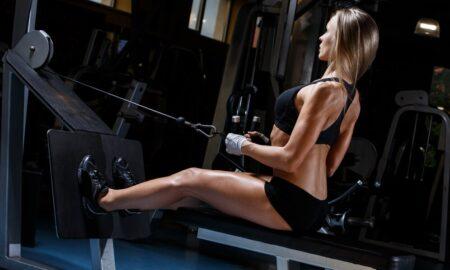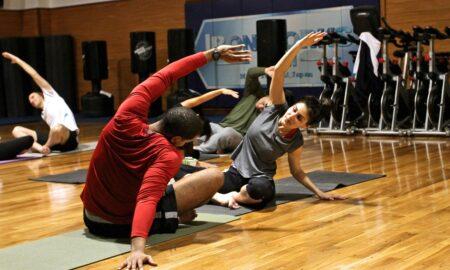John Little is frequently asked questions about Mike Mentzer's methods and approach to bodybuilding. Here are more of the common queries he gets about Mentzer and the science of bodybuilding known as Heavy Duty.
Higher Reps for Legs?
Q: I recently purchased the book you wrote with Mike, High Intensity Training the Mike Mentzer Way, and I love it! I've already read it through twice and am making progress at each and every workout. My question is, Why did Mike advocate higher reps (12 to 20, on pages 134 and 135) for the legs and lower reps (six to 10) for the upper body?
A: Thanks for your kind comments about the book. The reason Mike advocated higher reps for leg training is explained by random genetic variation within an individual's neuromuscular system. Research conducted during the early 1980s by Arthur Jones and associates at Nautilus Sports/Medical Industries (NSMI) in DeLand, Florida, corroborated Mike's view to a large extent. It indicated that the lower body requires a different type of training than the upper body. Mike once wrote about that discovery:
'NSMI found that the neurological efficiency of the legs'the number of muscle fibers activated during a maximal contraction'is extremely low. The neurological efficiency of the muscles in the upper body is considerably higher. Activating more muscle fibers in a maximal contraction involves more oxygen and lessens the muscles' endurance. Developing a muscle maximally requires regular stimulation of as much of the bulk of the muscle as possible.
'If you regularly stimulate 25 percent of the fibers in a muscle, that muscle will grow to a certain size. Stimulating 50 percent of that muscle's fibers would certainly result in more growth. Since a very small percentage of the thigh's muscle fibers are activated even on a maximum contraction, it would seem logical that the thighs require high reps to stimulate a high percentage of the fibers.'
That intrigued Mike, and he began to look into how many reps, ideally, should be used for leg training. I also recall that Ray Mentzer looked into the issue of performing higher reps for the legs and came to similar conclusions:
'Why so many reps [for the legs], you ask? Well, there are many reasons, but the basic one is this: Neurologically, the thighs have a much different pathway. If the leg or thigh neurons' firing rate was the same as that of your arms, delts or chest, you wouldn't be able to walk any distance. Do you ever get writer's cramp? Just think if you had that same firepower in your thighs. You wouldn't be able to get to your front door or climb steps. The thighs and legs have a structure that's neurologically designed for endurance'for long, heavy, arduous tasks. So overloading as heavy as possible for 10 to 20 reps will work much deeper fibers. Some people even do as high as 50 repetitions'I've even heard of up to 100'getting good results from only one set!'
Mike went on to conduct informal tests on various high-repetition schemes, as the NSMI research was only preliminary in the 1980s. He began by dramatically increasing the number of reps he did on each of his leg exercises. Whereas in the past he'd performed six to 10 reps, he upped it to 50, with the last rep being as close to failure as possible. He wrote:
'Your cardiovascular system will adapt to the increased demands so that you can move an appreciable weight to an approximately 50-rep failure. At that point try 75 reps per set, then 100 and beyond, but be sure to carry each set close to or actually to failure, and don't do more than two sets for the thighs.'
Even so, Mike found that past a certain threshold, performing higher reps had little to no effect on stimulating additional muscle growth. When he trained with repetitions above 20'say, 50 to 100'he was dividing the stimulus for adaptation between the aerobic (endurance) pathways and the anaerobic (or strength-and-size-building) pathways, compromising the muscle building effect in favor of the endurance-building effect.
By the 1990s Mike was not in favor of such excessively high-rep sets (if, indeed, he ever was), having experimented and not been duly impressed. He often said, 'Bodybuilding is not aerobics' and that you should train anaerobically'that is, with high intensity and brief duration'to keep the training stimulus solely within the anaerobic pathways so that you don't compromise your efforts. As such, he noted that performing reps beyond 20 was not only unnecessary but actually counterproductive.
Mike did hold, however, that the neuromuscular efficiency of the arms, for example, was much greater than the legs; so while you could thoroughly stimulate your biceps and triceps with a repetition protocol of only six to 10, the legs, by contrast, required more, the range of which he placed at 12 to 20, with 20 being the absolute top end. On all sets, however, whether for the legs or any other bodypart, Mike said that the key was to train with the highest intensity of muscular contraction you can generate and to take each set to a point of muscular failure.
ALLIs a Pump Necessary for Building Muscle?
Q: I know that Mike Mentzer believed that getting a pump did not necessarily mean that you had stimulated growth, but I like the feeling of having my arms pumped up. Ironically, I don't get a great pump at every workout, which has caused me to wonder what a pump is from a scientific standpoint and whether it can be affected by diet or drugs.
A: You're quite right about Mike's view of the pump. As he once pointed out:
'Jump down and pump out 30 rapid-fire pushups, and you should feel an appreciable pump in your pecs and triceps. It's doubtful, however, that those 30 quick pushups stimulated any growth, since the intensity was too low for a bodybuilder of any experience. Also, look at powerlifters and the manner in which they train. They get little in the way of pump, yet they're the most muscularly massive of all the strength athletes.'
It's also true that the pump does give you a good feeling, being the 'bodybuilder's rush and fix,' as described by Charles Gaines in Pumping Iron. Psychoanalyst Wilhelm Reich noted that all pleasurable sensations are characterized by the flow of blood and energy to the periphery of the organism from its center. That's felt subjectively as expansion'as in orgasm. So Arnold didn't realize how close to the target he was when he associated the pump with orgasm in the movie 'Pumping Iron.' You can enhance the selective redistribution of blood volume in the body, which is one way of describing the pump.
Remember that your muscles are more than 70 percent water and that the water is retained in the muscle by glycogen'three grams of water for every gram of glycogen'and the presence of electrolytes. If you've ever been on a low-carbohydrate diet for any length of time, you no doubt noticed the profound loss of water that results initially. Once you've used up the glycogen stored in the muscle, the water that was bound to it leaves the muscle. That not only causes the muscle to deflate, but it also leads to a loss of blood volume and a reduction in pumpability, as the pump is nothing more than the accumulation of blood and fluids in the muscle and its capillaries. Ordinarily, it occurs when you perform a number of reps, at least six or more, in immediate succession. The successive extensions and contractions literally pump more blood into the area. If, however, total blood volume is down and the fluid pressure within the muscle has been lowered'through a low-carb diet, for instance'it will be difficult to achieve a pump at all.
Obviously, total blood volume and fluid pressure inside the muscle are crucial. Maintaining optimal blood volume is simple enough: Make sure you eat a well-balanced diet that includes adequate carbohydrates, electrolytes and water. Chronic overtraining can lead to staleness and difficulty in achieving a pump. Overtraining prevents the body from ever fully recovering from the exhaustive effects of exercise. The muscles never completely regain their supply of glycogen and other nutrients.
Anabolic steroids enhance the pump only insofar as they cause the body to retain the electrolyte sodium and, hence, water. That definitely results in increased blood volume and fluid pressure. Uncontrolled, the sodium and fluid retention that results from steroid use can raise blood pressure to dangerous levels, so taking steroids is not a safe, reliable way to enhance your pumps. Eat a well-balanced diet, get adequate rest, don't overtrain, and you should never have any trouble getting a pump.
I'll also pass on another of Mike's observations in regard to the pump. He made it in Gold's Gym, where he conducted his personal-training business. One day we were both in the gym, and a young trainee came up and began to question Mike about his Heavy Duty methods. The young fellow launched into a series of objections, which Mike listened to with far more graciousness than his behavior warranted. The fellow concluded by saying, 'High-volume training gives a great pump to the muscles, and the pump is the only thing that stimulates muscle growth.'
Mike raised an eyebrow, and a grin spread across his face. 'Young man,' he began, 'take a look around you in this gym. You will see that almost every bodybuilder in here is getting a good pump today. If the pump were the sole factor that resulted in muscle growth, then each of these gentlemen would be sporting 25-inch arms, a 60-inch chest and 30-inch thighs'because some of them have been getting a 'good pump' at each and every workout, year in and year out, for more than 15 years. I've been around this gym for that long, and it's been my observation that not one of those people has gotten any bigger; they all look the same because they have not increased the intensity of their muscular contractions. They have all pumped and pumped and pumped, and they all felt good about their training efforts because the temporary eschemia the pump provided made them feel bigger than they were before they worked out. When they left the gym, however, their pumps subsided'as it is only a temporary filling of the vasculature with blood'and their muscles returned to the same size they were before the workout.
'Everybody gets a pump, but not everybody gets bigger. A pump is never an indicator of muscle growth being stimulated and, in truth, has virtually no effect at all on the muscle-building process accept in the case of rank beginners.' The young fellow's jaw went slack, and I can still see his face, looking as though his world had just changed, as Mike and I left Gold's.
Sugar and Carbohydrates
Q: There is so much written these days about the harmful effects of carbohydrates and sugar. In reading Mike Mentzer's writings on the subject, I don't find him condemning sugar or carbohydrates. I find that odd.
A: Mike looked into the issues of nutrition very thoroughly, and he had reasons'valid, scientific reasons'for not climbing on the anticarbohydrate, antisugar bandwagons:
'When you go on a zero-carbohydrate or low-carbohydrate diet for any extended period, the body will make its own carbohydrate by converting protein and fat to sugar. If sugar is so evil and the body doesn't need it, why does the body manufacture its own when there is a deficiency in the diet? The answer obviously is that the body needs sugar to survive and remain healthy. In addition to being the most efficient source of fuel for the muscles, sugar figures centrally in a host of other physiological needs. The brain derives almost 100 percent of its nutrition from sugar. Ever notice the diminished concentration and short-term memory that attends going on a low-carb diet, not to mention the irritability? These are signals that the body sends for sugar.'
So by all means include carbohydrates in your diet, but be sure to eat those that contain other essential nutrients, such as minerals and vitamins. That way an occasional candy bar or ice cream cone will do absolutely no harm. As a matter of fact, many physical educators recommend that the athlete's daily calorie consumption contain up to 65 percent carbohydrates, with the rest divided between fats and protein. Keep in mind that muscle tissue is made up almost entirely of water and that glucose is instrumental in keeping water in the muscle cell. Nutrition scientists are discovering that sugar (unrefined'stick with natural sugars such as fruit sugar) is not the villain it's been made out to be'it may actually turn out to be the bodybuilder's best friend.
Mike also pointed out that many of the so-called 'diseases of civilization'diabetes, hypoglycemia, gout, ulcers, cardiovascular disease, dental caries, alcoholism and even mental illness'have been blamed on refined carbohydrates, but, he believed, refined sugars are no more toxic than any other nutrient. Fat, protein, vitamins, minerals and even water can be harmful and even fatal'if consumed in large enough quantities; however, the human body needs all of those substances. It has mechanisms for using them and mechanisms for dealing with quantities in excess of specific needs.
Of course, certain people have defective mechanisms; diabetics, for instance, can't deal with excessive sugar intake as successfully as other people. If you do not have such a condition, then removing sugar or other carbohydrates from your diet can only cause problems'both to psyche and soma.
[Note: For a different view, see 'Low-carb Diet: Unjustly Accused' in this same issue.]
Editor's note: John Little is now available for phone consultations to educate and elaborate on Mike Mentzer's revolutionary Heavy Duty training system. For information on rates and information, contact Joanne Sharkey at (310) 316-4519, visit www.mikementzer.com, or go to Home-Gym.com. IM




















You must be logged in to post a comment Login